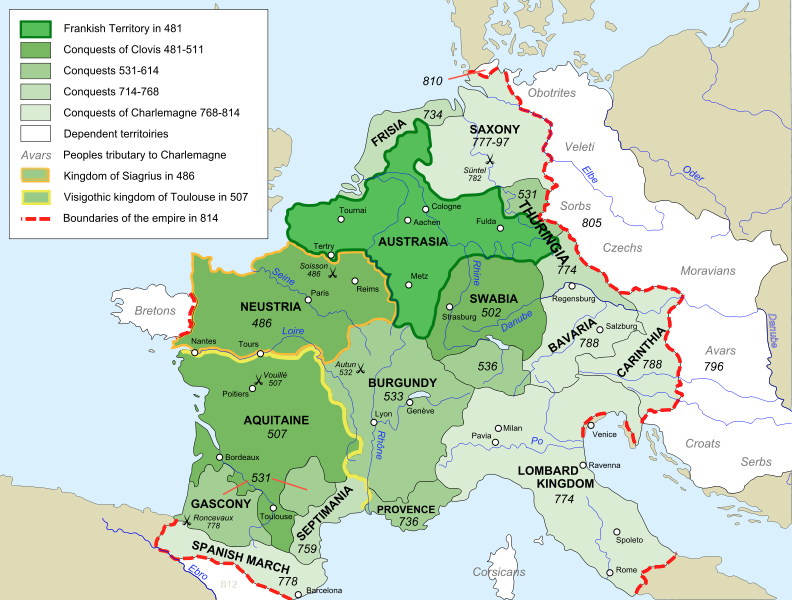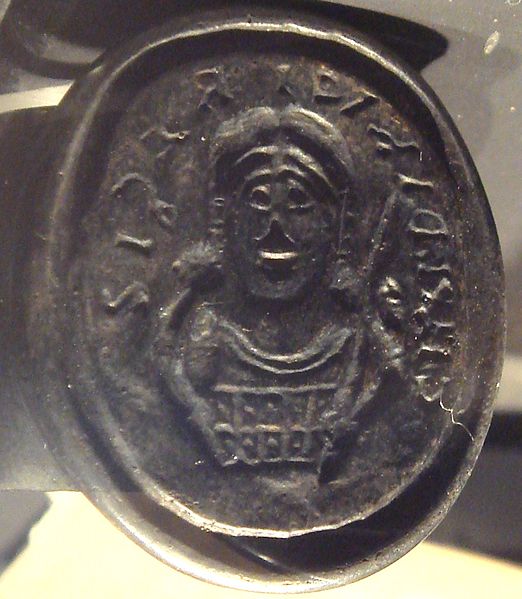You have probably heard of Charlemagne, one of the mediaeval period’s most widely recognised kings. Like me, you may even have suffered through a textbook’s protracted glorification of Charlemagne’s achievements as a ruler. Although undoubtedly significant, however, Charlemagne’s reputation has benefitted enormously from a biography written about him shortly after his death. Einhard’s Life of Charlemagne is only one of the earliest sources to have survived which actively sought to discredit Charlemagne’s predecessors–the Merovingians. Even today, this dynasty is little known and much criticised for their dissolute and ineffective kingship.
No matter our judgement of their individual failings or institutional weaknesses, though, the fact remains that they ruled an area roughly analogous to modern France (and parts of Germany) from the rule of Childeric I in the mid-5th century until the papal deposition of the last Merovingian king in 752. This period was a time of great social transitions, as Roman structures of authority in Gaul were re-imagined and Germanic kingdoms came into being.

Francia from the beginning of Merovingian times through to the early Carolingian period. (Wikimedia)
As scholars have struggled to understand the nature of Merovingian kingship within this shifting ideological and political landscape, they have spilled a shockingly large amount of ink on a rather bizarre Merovingian trait: their long-haired kings.
As we might expect, Einhard, as a propagandist for the successors of the Merovingians, had something rather unflattering to say about their royal habits. He remarked in his Life of Charlemagne that a Merovingian was ‘content with the name of king only, with his long hair and flowing beard,’ which gave the appearance of sovereignty without any substance. His contention that long hair was a particularly kingly attribute for the Merovingians is corroborated elsewhere, and in more detail.
The 6th century historian Agathius, for example, wrote that ‘It is the rule for Frankish kings never to be shorn; instead, their hair is never cut from childhood on, and hangs down in abundance on their shoulders. … Now this it is their custom to set apart as a distinguishing mark and special prerogative for the royal house. For their subjects have their hair cut all round, and are not permitted to grow it further.’
This striking image of Merovingian kings and their hair, which here takes on a nearly magical property, has fascinated generations of historians. Some have argued that it was merely a matter of rank and status; after all, long, loose hair is hardly practical. Throughout the twentieth century, it was also popular to argue that their hair was the physical trait in which the spiritual authority of Germanic kings had been vested since ancient times. These Merovingians were thus continuing a practice of sacral kingship that had existed since classical times.

The signet ring of Childeric I, from the 5th century, depicting a centrally parted, long hair style. (Wikimedia)
Certainly, the Merovingians took the requirement of royal locks seriously. Deposed kings or potential heirs are regularly tonsured and depositied in monasteries in order to remove them from power. If these same individuals wished to make a come-back, regrowing their hair was apparently non-negotiable. (Gregory of Tours‘ work is full of such allusions.)
Now, however, the preference is to set the Merovingians within a more Christian context, by noting the similarities between the Merovingian attitude to long hair and the figure of Samson in the Old Testament. If this is the case, than the Merovingians–made famous in historical tradition by a tale in which their ancestor Merovech was descended from a sea-monster–become rather less interesting, but also rather more comprehensible. Early mediaeval kingdoms, from the Visigoths to the Carolingians, were known to model their political traditions from the Old Testament, resulting in the later widely spread practice of anointing (that continues in Britain today.)
Thus, although many aspects of their history remain murky, the long-haired kings’ most distinguishing feature may now be explained. Whether their fashion will ever be revived by modern day political figures, however, is another matter entirely.
Learn More:
The passage from Einhard’s Life of Charlemagne was quoted from Cameron, Averil, ‘How did the Merovingian Kings Wear their Hair?’ Revue Belge de Philologie et d’Histoire 43.4 (1965), pp. 1203-1216.
Agathius quoted from Goosmann, Erik, ‘The Long-Haired Kings of the Franks: “like so many Samsons?”‘, Early Medieval Europe 20.3 (2012), pp.233-259.

Hmm very interesting, hirsute post, Marissa. Thanks! FYI Agathius, who you quote, should be spelled Agathias correctly. Scott
Every time I hear the name Charlemagne I have the image in my head of the imposing green equestrian sculpture in front of Notre Dame Cathedral. It portrays him as a mighty, larger than life character. Then later I learned that in reality he was a rather stout, squat, and balding man, and that most visual representations of him have greatly exaggerated his physical stature. It goes to show you that any history trickling down to us from so long ago is sometimes only a fraction of the truth. I’m not surprised we’ve been fed such a biased account of these gents!
This is my favorite time period! A few weeks ago I wrote about Childeric’s Bees. I don’t know why but I’m obsessed with them. http://jauntingjen.com/2013/07/21/the-story-of-childerics-bees/
Thanks for reading, and sharing! I’ll be sure to check it out.
There’s definitely something about the Franks that makes them fascinating, if a little eccentric.
I know they are fascinating. They had the remains of a Frankish tomb in the Romano-Germanic Museum in Cologne, it had a still unopened bottle of wine and lots of that gold and garnet cloisonee they seem so fond of.
Great post, and interesting trivia about the Merovingian hair!
The past is a crazy place. I was just reading about how Henry ordered Irish men to shave off their moustaches – it apparently had something to do with emasculating them,
I loved this bit: “If these same individuals wished to make a come-back, regrowing their hair was apparently non-negotiable.” Would wigs have been acceptable or was one forced to wait the few months?
Oh yes, yes it is.
That’s an interesting question, and not one I have a sure answer to. From the reading I’ve done, though, wigs never entered the picture, but then again, historians aren’t sure quite how long royal hair had to be in order to be counted.
Shoulder length? Longer?
At least this method is less violent than the Byzantine predilection for blinding deposed emperors before depositing them into a monastery (if they survived).
And OMG, just noticed the pun in the title. 😀
You’re welcome 😀
Great article. Very informative and easy to follow, and you have a great, natural-feeling writing style. God bless!